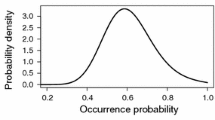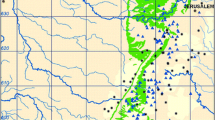Summary
A new method is proposed for detecting key factors from life tables for animals whose life-cycle is divided into several stages. This method is based upon an equation that partitions the variance of the number alive at the end of the life-cycle into components associated with variation in the number entering the first stage of the cycle, variation in survival rates, and also density-dependent aspects of survival. It is illustrated by analysing Blank and Ash's (1962) census data for a population of partridges. The conclusions reached are somewhat different from those reached by Blank et al. (1967) when they applied Varley and Gradwell's (1960) type of key factor analysis to the same set of data.
Similar content being viewed by others
References
Blank, T.H., Ash, J.S.: Fluctuations in a partridge population. In: The exploitation of natural animal populations (E.D. Le Cren and M.W. Holdgate, eds.) pp. 118–130 Oxford: Blackwell 1962
Blank, T.H., Southwood, T.R.E., Cross, D.J.: The ecology of the partridge. I. Outline of the population process with particular reference to chick mortality and nest density. J. Anim. Ecol. 36, 549–556 (1967)
Hassel, M.P. and Huffaker, C.B.: Regulatory processes and population cyclicity in laboratory populations of Anagasta kuhniella (Zeller) (Lepidoptera: Phycitidae). III. The development of population models. Res. Popul. Ecol. 11, 186–210 (1969)
Ito, Y.: On the methods for determining density dependence by means of regression. Oecologia (Berl.) 10, 347–372 (1972)
Luck, R.F.: An appraisal of two methods for analysing insect life tables. Can. Ent. 103, 1261–1271 (1971)
Metcalf, J.R.: An analysis of the population dynamics of the Jamaican sugar cane pest Saccharosydne saccharivora (Westw.) (Hom. Delphacidae). Bull. Ent. Res. 62, 73–85 (1972)
Podoler, H., Rogers, D.: A new method for the identification of key factors from life table data. J. Anim. Ecol. 44, 85–115 (1975)
Varley, G.C., Gradwell, G.R.: Key factors in population studies. J. Anim. Ecol. 29, 399–401 (1960)
Varley, G.C., Gradwell, G.R.: Population models for the winter moth. In: Insect abundance (T.R.E. Southwood, ed.), pp. 132–142. Symp. Roy. Ent. Soc. 4 (1968)
Varley, G.C., Gradwell, G.R.: Recent advances in insect population dynamics. Ann. Rev. Ent. 15, 1–24 (1970)
Varley, G.C., Gradwell, G.R., Hassel, M.P.: Insect population ecology. Oxford: Blackwell 1973
Author information
Authors and Affiliations
Rights and permissions
About this article
Cite this article
Manly, B.F.J. The determination of key factors from life table data. Oecologia 31, 111–117 (1977). https://doi.org/10.1007/BF00348714
Received:
Issue Date:
DOI: https://doi.org/10.1007/BF00348714




